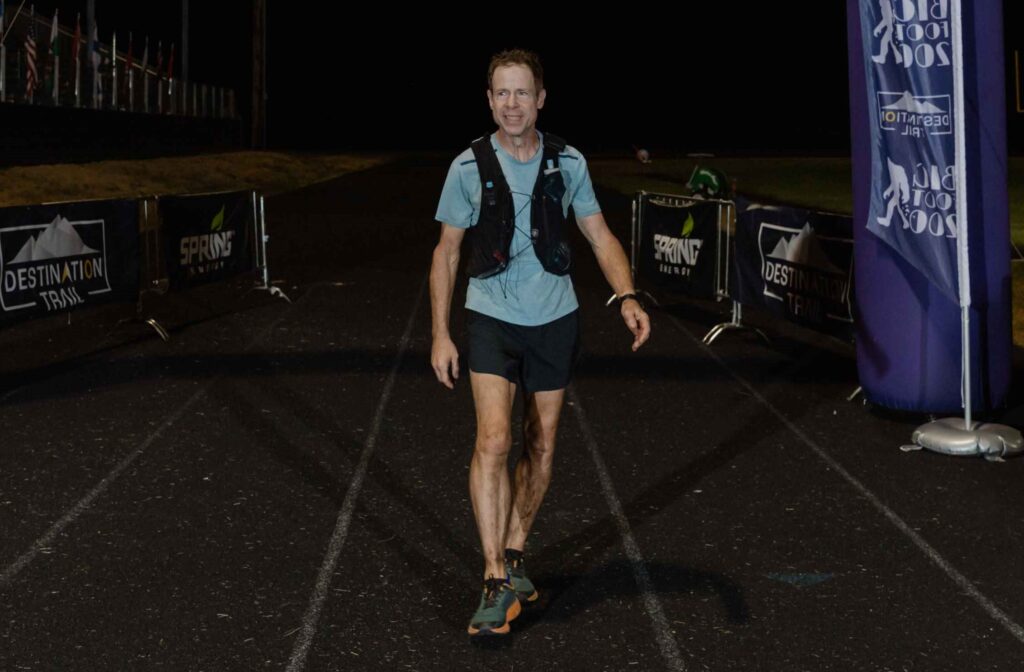
Introduction
Eighteen days after finishing the Tahoe 200 I was standing at the starting line of the Bigfoot 200. This was not supposed to happen. The races had originally been scheduled two months apart. Of the 198 runners competing in Bigfoot 200, forty-two of us were in the same unfortunate position of just coming out of Tahoe 200. All forty-two of us were participants in a three-race series known as the Triple Crown of 200s, and mother nature had conspired to change our best-laid plans for a good recovery between races. Snowfall had been heavy throughout the winter, and the snowpack around Lake Tahoe was at record depths. To avoid the snow, Tahoe 200 had been pushed back from early June to late July.
Eighteen days was not enough time to recover from the 206-mile effort that Tahoe 200 had been. Not for me, anyway.
Regardless, the Bigfoot 200, a 208-mile race with more than 45,000 feet of climbing through the Cascade Mountains in Washington State, would begin on schedule the morning of Friday, August 11, 2023.
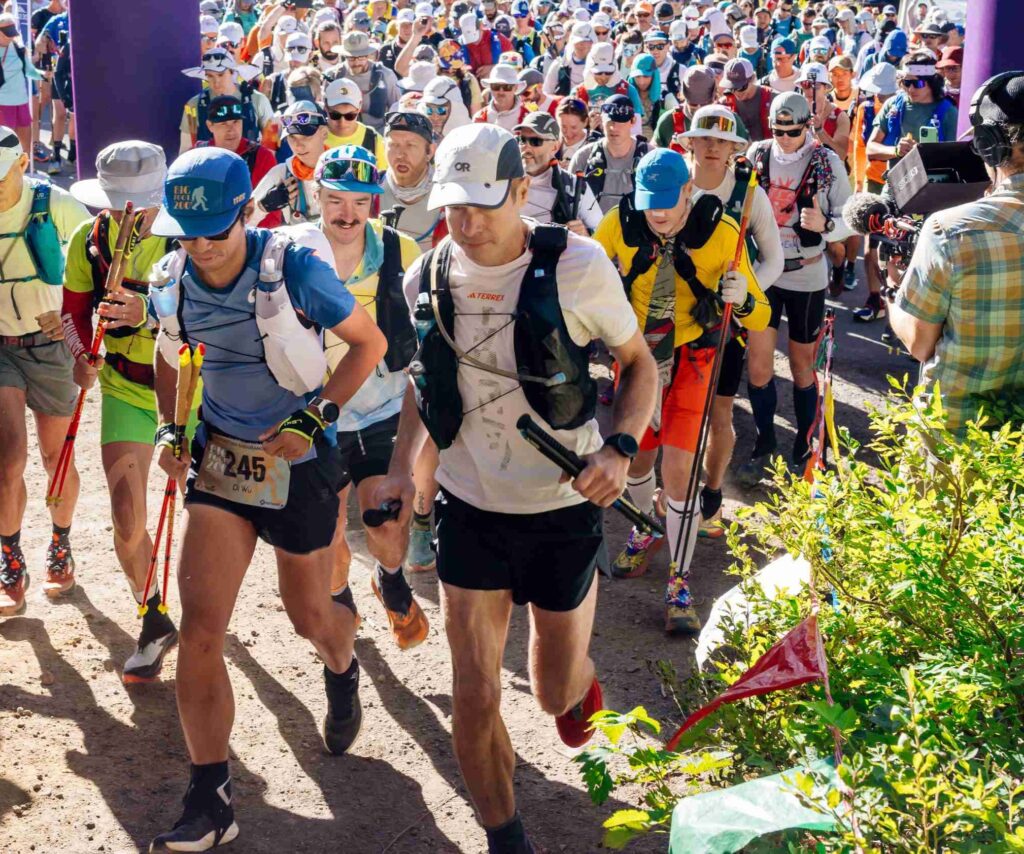
Start to Windy Ridge (miles 0 to 29)
The night before Bigfoot I got six hours of sleep. This was the most I’d slept before a 200-miler since 2016, and it put me in good spirits as I did my morning preparations. Mentally, I was ready to run and I was ready to race. Bigfoot 200 followed a beautiful course through the Cascade mountains, and I had never run a bad race there. It had been my first 200-miler back in 2015, and the three subsequent times I had run it, I’d finished in first, second and third place.
At 9 AM all 198 runners began a slow surge forward, passing beneath the starting line arch and onto the trail. The 2023 edition of the Bigfoot 200-Mile Endurance Run had begun.
I kept my pace controlled and easy, gliding as smoothly as possible up the gentle slope. A canopy of evergreen branches high above the trail protected me from the morning sun. I enjoyed the shade while it lasted, knowing the course would soon be taking me across the hot, exposed desolation of the Mt. Saint Helens blast zone. The blast zone had been decimated in 1980 when the Mt Saint Helens volcano erupted in a massive explosion.
I sustained my low effort for the first hour, letting my muscles gradually warm up. After that, I increased my intensity just a little to more of a race pace. The first twelve miles passed quickly. People around me were chatting, and I could feel their energy and excitement.
I came into Blue Lake aid station, mile 12, focused on efficiency. This was planned as a quick stop, and essentially consisted of simply topping off my water bottles and then grabbing the electrolyte bottles from my drop bag and stuffing them into my hydration pack. The small amount of food I needed for this section had been in my pack from the start. It was a good stop for me, requiring less than five minutes despite the crowding inherent with runners from both the 40-mile and 200-mile races arriving at the aid station at the same time.
Heading toward Windy Ridge, I ran with a couple other people for a while as we made our way across Coldspring Creek and ascended the trail that would skirt us around Blue Lake toward the blast zone. Soon, the small group broke up as each of us settled into our own pace.
It was a hot day, but not as hot as I remembered the 2021 and 2022 races being. It helped that the streams were flowing well through the area, providing me with opportunities to refill my bottles, and saving me from needing to carry as much water in my pack as I otherwise would have. I kept a measured pace as I weaved my way through the boulder field of large rocks that had been tossed there by the 1980 blast from Mt. Saint Helens.
When I hit the out-and-back road to Windy Ridge aid station my legs were still feeling strong. I kept an easy jog along the road, admiring the views out toward Mt. Adams.
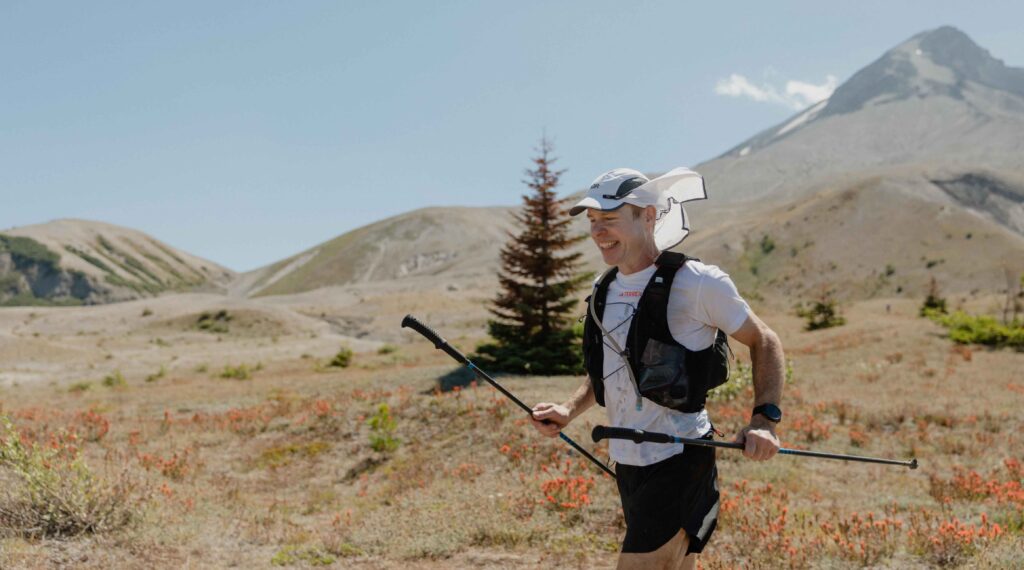
Windy Ridge to Coldwater Lake (miles 29 to 45)
Heather was ready for me at Windy Ridge aid station with a chair and a selection of food options. I ended up drinking two full bottles of chocolate milk, which put me above my caloric goal for the stop. In light of that, I didn’t need to take any more food with me beyond the couple items Heather had already added to my pack. When she asked if I still wanted to walk out of the aid station with a muffin, as my plan called for, I probably should have turned it down or wrapped it and put it in my pack. After the milk, the muffin just wasn’t needed. But I decided to take it anyway. Overstuffing my stomach during the heat of the day was typically a bad idea, but I was feeling so good that I thought the bonus calories would only help me.
A few miles out of Windy Ridge I had already eaten all but a small portion of the muffin when my stomach started feeling a little uneasy. I stopped eating the muffin and switched back to a diet heavier in fluids, but, the almost-sick feeling stayed with me a long time anyway, coming and going intermittently all the way through Coldwater Lake and on to Norway Pass, a distance that took me eight more hours to traverse. Eight hours of feeling poorly did not result solely from the muffin, of course. It was merely one ingredient in a recipe of heat, exposure, running just a little too fast for the temperature, and eating a little too much food. With those elements as the spark, the problem compounded itself when the stomach issues prevented me from taking in enough water, electrolytes and calories to keep my engine running well. It certainly wasn’t a disaster, but it did reduce my pace considerably.
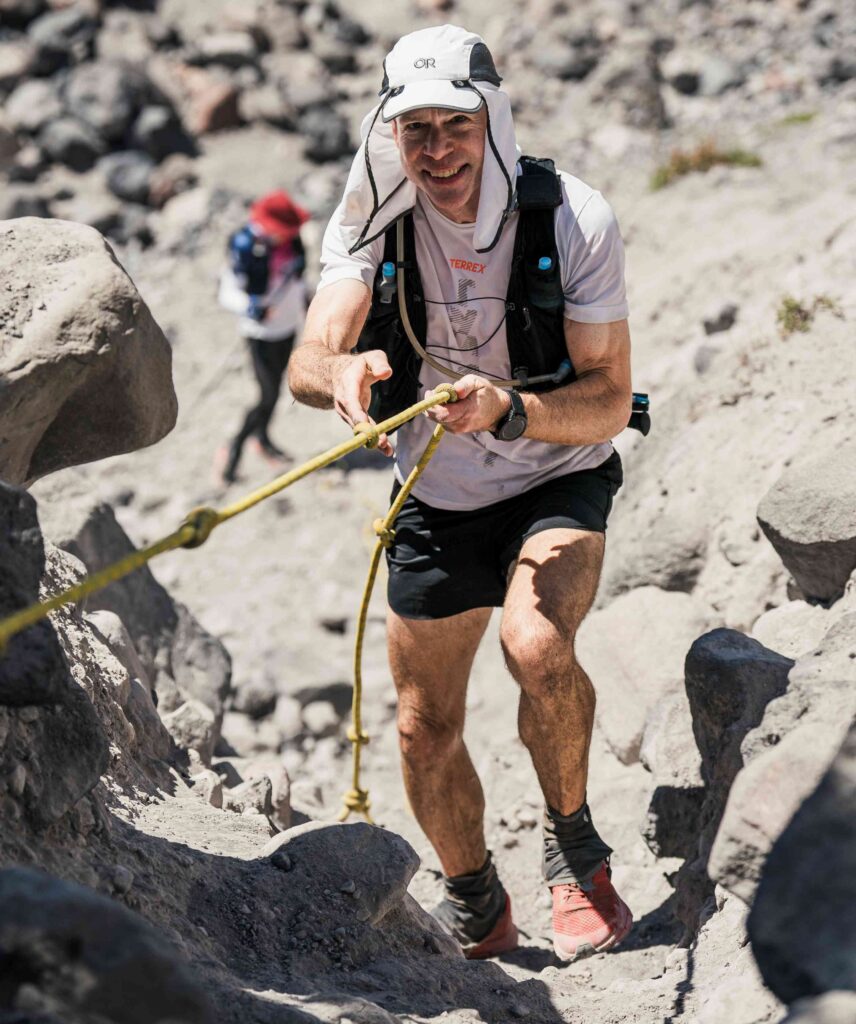
Coldwater Lake to Norway Pass (miles 45 to 64)
My stomach was going through one of its more settled periods as I approached Coldwater Lake, mile 45. Aliza Lapierre had passed me a little while before the aid station, and I arrived just behind her. She departed the aid station ahead of me and I never saw her again as she ran her way to a 5th place overall finish.
Coldwater Lake was another quick stop for me, clocking in around 8 minutes. Norway Pass aid station was almost 19 miles away. The route consisted of a few gently rolling miles of trail alongside the lake, an arduous, 8-mile climb to the top of Mt. Margaret, and then a 6-mile descent to Norway Pass.
With a stomach that was still on the edge of sickness, I found the warm electrolytes in my bottles to be almost undrinkable as I worked my way around the lake. To solve this problem, at one of the streams I dumped a portion of each of the electrolyte bottles onto the ground and then added cold stream water to top off the bottles. This helped make the drinks a little cooler, but they still weren’t going down easily. Fortunately, the sodium from my salt tablets, potatoes, and the portion of the electrolyte beverages I was able to actually drink allowed me to keep my body in some semblance of fluid / electrolyte balance through the first part of the section. Unfortunately, I wasn’t able to sustain this beyond the first seven miles, and I vomited three times during the latter miles.
Approaching Norway Pass, I knew I needed to absorb plenty of calories, fluids and electrolytes. This was going to cost me a bit of time, but I didn’t see another option that would get me feeling good again. I was happy Heather was going to be at Norway Pass, because I knew she would help me get back on track.
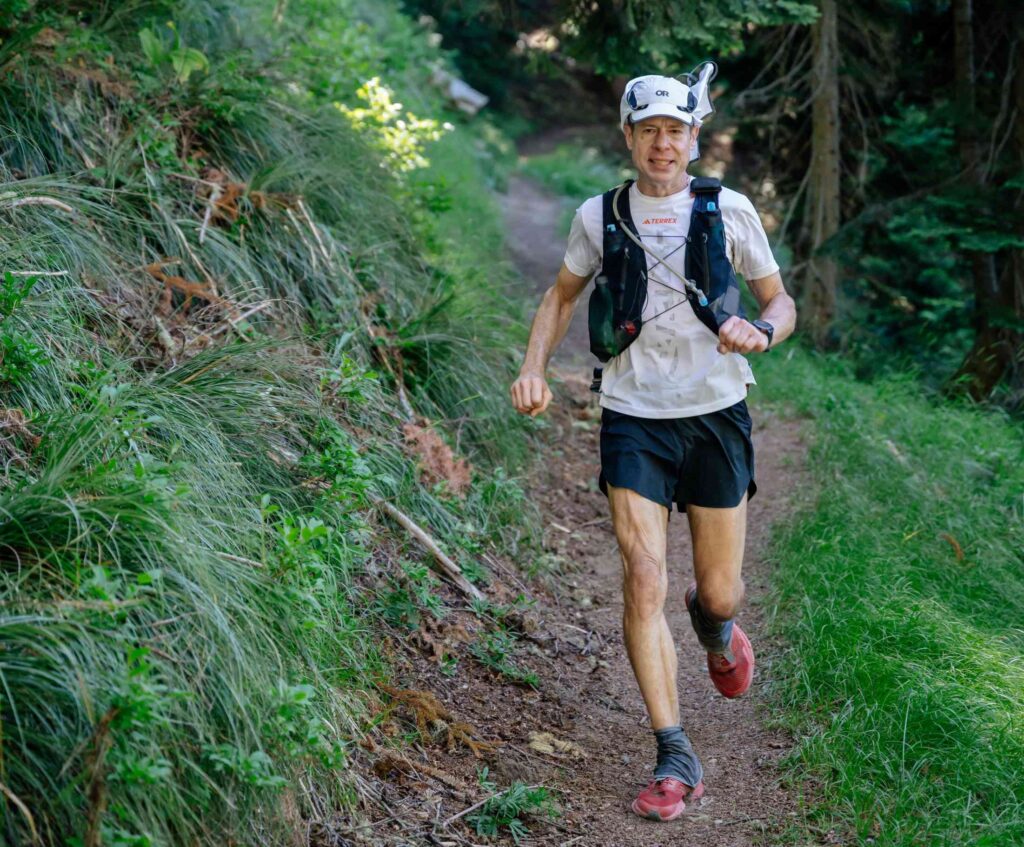
Norway Pass to Road 9327 (miles 64 to 90)
I arrived at Norway Pass at 11:50 PM, and departed at 1 AM, a total of 70 minutes. In that time, I had dropped from fifth place to tenth place as runners came into the aid station behind me and departed ahead of me. I didn’t care. I needed to fix myself first, and worry about other things later.
I drank water, hot chocolate and a fruit smoothie. I took 1700 mg of sodium in the form of salt tablets. Taking so many salt tabs in such a short time, I was concerned about overdoing the other supplementals that were in my salt tabs, and I just wanted something with more punch per capsule. Fortunately, Keith Levasseur, a four-time 200-mile veteran who was volunteering at Norway Pass, gave me a number of tablets that were straight sodium. Keith’s help at Norway Pass, and the help of so many other volunteers at aid stations along the way, was invaluable.
Heather added food to my pack, replaced my empty bottles with full ones, and then sent me on my way. I made a decision to walk the first three or four miles. I had invested a lot of time at the aid station to get my body back in balance, and I was worried that if I started pushing myself at a higher intensity too soon, I would throw myself back into the position from which I’d just escaped.
Forcing myself to keep walking on the easier portions of the trail was challenging. Runners passed me. Still, I walked. I had dropped back to 13th place by this point, although I assumed at the time that I was even farther back in the field than that. On multiple occasions, when I really felt the urge to start running again, I reminded myself out loud in the darkness of the early morning that “I’m just walking, that’s all. I’m not racing, just walking.” It helped that I was in the right headspace. I was feeling positive, I was moving faster than just casual walk, and I knew that when my stomach had fully settled and I was strong, I would pick up my pace. I just wanted to give the race my best effort, and ideally create a little more space between me and the other runners in the Triple Crown.
The Triple Crown of 200s consisted of running Tahoe 200, Bigfoot 200 and Moab 240 all in one year. There were 42 Triple Crown entrants for 2023, all of whom faced the same hurdle as me: running Bigfoot a paltry 17 or 18 days after finishing Tahoe. Rankings in the Triple Crown were determined by cumulative times for all three races combined. At Tahoe, I had built a bit of a gap between me and the other Triple Crowners, putting me in the first-place position. As long as I finished ahead of the other people doing the Triple Crown, I would widen that gap, which, in turn, would put me in an even stronger position going into the final race of the series, Moab 240.
After those first four miles of walking out of Norway Pass, I shifted again to running, and it felt good. I kept a steady intensity through the remaining nine miles to Elk Pass aid station, and passed a couple of the guys who had passed me when I was walking. I was pretty certain there were no Triple Crowners ahead of me, but even if one or more of them were ahead of me I couldn’t change anything anyway. I was doing the best I could. My stop at Elk Pass aid station was efficient. I swapped electrolyte bottles, filled the hydration bladder, and then stepped back on the trail within ten minutes.
The fifteen miles from Elk Pass to Road 9327 aid station went by quickly. Even if my legs were still feeling the deleterious effects of Tahoe, my energy was back where it needed to be and all of the stomach issues had passed. I left Elk Pass around 4:30 AM, so it wasn’t long before the sun was coming up. I stopped to fill up a water bottle in a small pond, but otherwise I kept myself moving forward.
The last portion of the trail to Road 9327 is a nice, long descent. Every time I start that descent it feels good to know I’m about to hit the aid station. The one part of this year’s descent I could have done without was the pair of kids on motorbikes who were blasting through the overgrown part of the trail right near the bottom, careening blindly through the bushes as if there was no chance anyone would be on the trail but them. Fortunately, my motorcycle dodging skills seemed to be working well that morning.
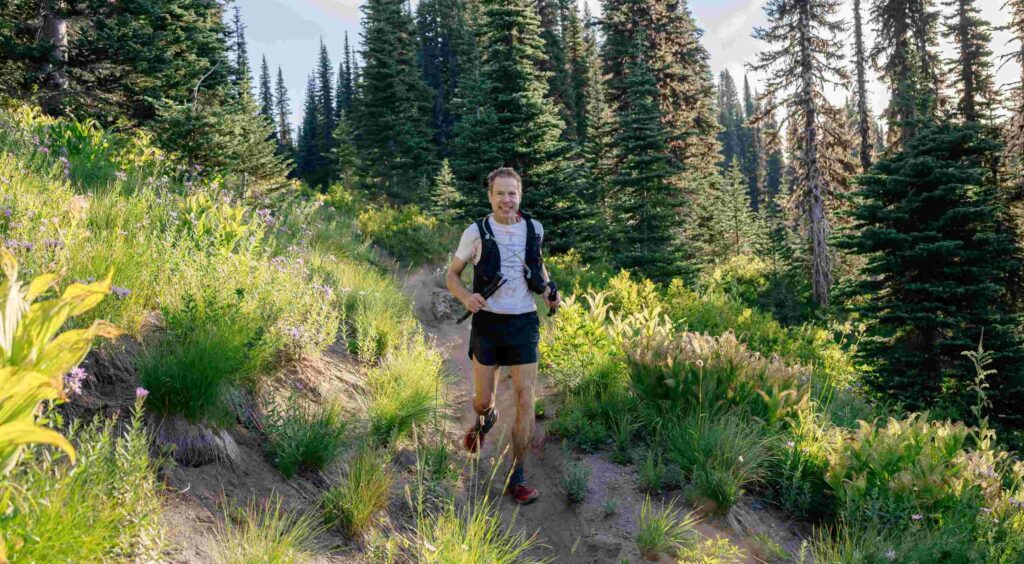
Road 9327 to Lewis River (miles 90 to 109)
I arrived at Road 9327 aid station a little before 9 AM Saturday morning, 90 miles and 24 hours into the race. When Heather sent me on my way fifteen minutes later, it was a short but slow 11-mile jaunt to Spencer Butte aid station.
From Spencer Butte, the route stayed on a paved road for 2 miles before turning onto the quad-burning, toe-crushing, singletrack descent to the Lewis River. Although I knew this wouldn’t be my best tactical decision of the race, I decided I was going to have some fun with the descent regardless of what it did to my quads. I really just wanted to enjoy the fact that I was feeling better. I wasn’t exactly blazing down the descent like I have in a couple of my previous years at Bigfoot, but for someone running on Tahoe-tired legs, I took it pretty quickly.
On the way down, I passed a couple guys who were taking a more conservative approach to the steep, downhill trail. They had their poles out, and were using them as brakes to take the load off their quads. The two guys, Forest Deak and Paul Chisolm, would end up ascending from the Cispus River to the top of Elk Peak with me almost 40 miles later as we headed toward Klickitat.
Lewis River to Quartz Ridge (miles 109 to 126)
The trail from Lewis River aid station repeatedly climbs away from Quartz Creek and then descends back to the creek before finally beginning a long ascent that leads to Quartz Ridge aid station. With 7300 feet of climbing and 4500 feet of descending spread across only 17 miles, this is a section that challenges both the body and the mind. I was prepared for the climbs, but what frustrated me was fact that in many places the foliage had overgrown the trail where in previous years it had been much more of a free-flowing route. I tried not to let the frustration affect my motivation to push hard on the ascent, but I’m sure it was a factor in the slow progress I made throughout much of the route to Quartz Ridge.
As I descended along the out-and-back toward Quartz Ridge aid station, Allison Powell passed me going the opposite direction. I didn’t know it then, but she would end up motivating me to put a little extra fire in my stride near the end of the race.
Quartz Ridge to Chain of Lakes (miles 126 to 142)
I arrived at Quartz Ridge aid station a little before 10 PM, and asked the medic if he would take a quick look at my left foot. Blisters were typically unheard of for me, but I was concerned one might be forming on one of my toes. If it was happening, I wanted to catch it early before it became worse. It turned out it was merely some skin rubbing off a callous between two toes, so we took no action and just let it be. The minor pain was something I could deal with. I was sure the root cause of the problem was the fact that my feet had not had an opportunity to completely go through their healing cycle after Tahoe. Typically, after a 200-miler my feet sluff off excess layers of skin, and then they rebuild more durable layers. Without adequate time to complete that process, I probably had extra layers of dead skin that were more vulnerable to the friction of running and these layers were rubbing on the healthy skin beside and beneath them.
Before I departed the aid station, I laid down in Heather’s crew vehicle to close my eyes. She was going to get me up after five minutes, but I clambered out of the truck a minute or two early, ready to go. It was approaching 1 AM, and it wouldn’t be long until I hit the hours of the night that were always the toughest for me when it came to staying alert. 2 AM to 5 AM.
I was moving well for the first couple miles of trail, but soon I started feeling drowsy. I increased my effort level, pushing myself faster along the trail. That worked to keep me focused for a while, but then I began an extended climb I recognized as the same place at which I had laid down in 2022 in a fruitless attempt to fall asleep. After that failed attempt in 2022, I felt like I had sleepwalked through what should have been a relatively easy section. This year I’d committed myself to keeping the caffeine flowing and keeping my intensity at a level that would inherently help to keep me awake all the way to Chain of Lakes aid station 16 miles away
My body had a different idea regarding this commitment I had made. My body wanted to shut down and recharge. I could not stay focused, and I kept slipping into a sleepwalking mode, shuffling slowly up the same ascent that I remembered well from 2022. Finally, I had to yield. If I didn’t at least close my eyes for a few minutes I was going to repeat the 2022 debacle. I stepped off the trail, pulled my emergency blanket from my pack and curled up on the slope with my pack as a pillow. Five minutes later my alarm went off. I felt refreshed. I got up, did my best to crumple the space blanket into a tiny ball that would fit in my pack, and resumed the climb.
My 5-minute rest paid off. I was moving better and my mind was clear. When I hit the rock-strewn road descent where last year I’d continued stumbling mindlessly along, this year I was able to weave a path through the rocks that allowed me to take advantage of gravity’s helpful downward pull. Although my pace through this section didn’t match my fastest years, it was still more than 2 minutes per mile faster than last year’s lethargic shuffle. Mission accomplished.
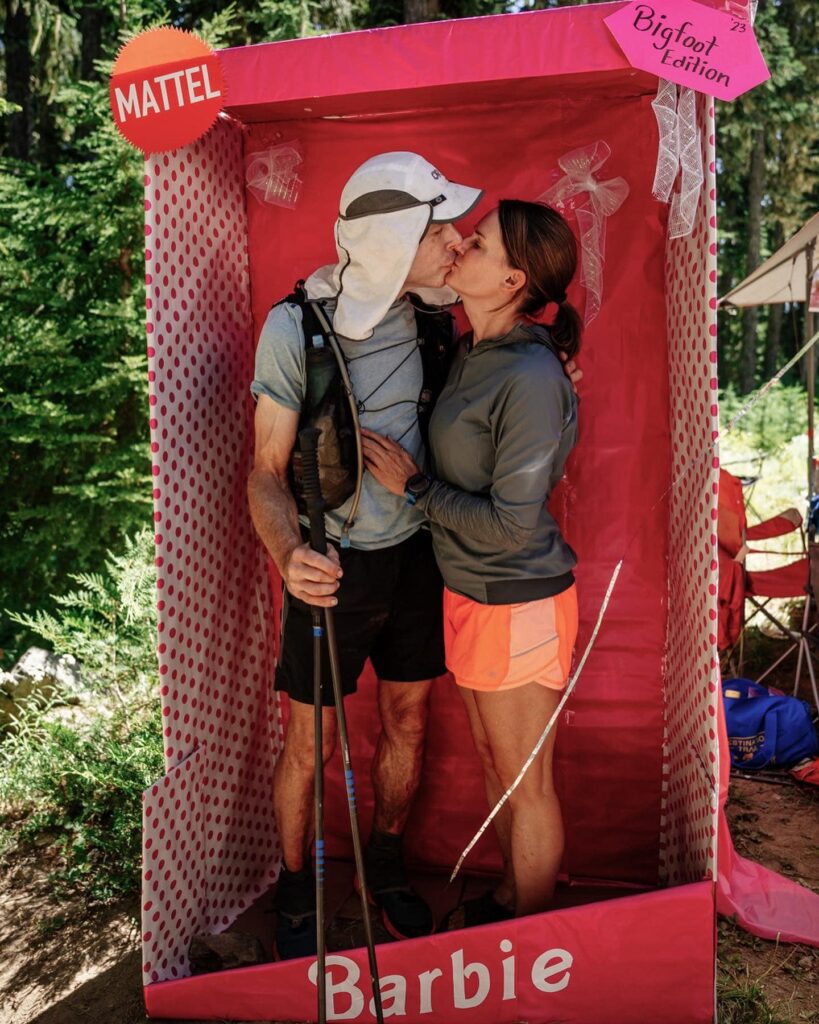
Chain of Lakes to Klickitat (miles 142 to 160)
In the plan I put together before the race, I’d designated Chain of Lakes aid station as the place at which I’d sleep if a longer period of sleep was needed. Based on the struggles with tiredness I’d fought during the early miles of the previous section, I decided the 5-minute dirt-naps weren’t going to sustain me, so when I arrived at Chain of Lakes, I told Heather I was going to need to sleep for 90 minutes.
After eating, I made my way to one of the sleep tents and laid down on a cot. I struggled to fall asleep initially, but, in the end, I drifted off for twenty minutes or so. I lay there for another few minutes before getting up to find Heather and to start getting my gear on. I’d spent 45 minutes in the tent.
I walked the short descent from the aid station to the first river crossing, and then kept a steady jogging pace on the flats, downs and the easier ups all the way to the Cispus River. Paul and Forest, the runners I’d passed 40 miles earlier during the descent to Lewis River, had apparently passed me while I was sleeping at Chain of Lakes, and were sitting on the opposite side of the river, apparently to rest before the big climb to Elk Peak. They started moving about the time I stopped in the middle of the river to refill a couple water bottles, but I caught up with them a few minutes later.
We started chatting as we hiked and ran toward the ascent to Elk Peak, and were apparently more focused on the conversation than we should have been because we managed to make a wrong turn that cost us a little over a mile. Once we were back on track, the ascent began.
Other than portions of the first 35 miles of the race when the pack hadn’t yet broken up entirely, the 7-mile ascent from Cispus River to Elk Pass was the only time I ran with anyone. I was neither avoiding running with others nor seeking others to run with. Aside from a runner I chased on the way to Twin Sisters, I just didn’t ever see any other runners for the other 162 miles of the race, so it was never an option. This is how it always goes.
It was a hot morning as we hiked up the multiple false summits on our way to Elk Peak. The three of us moved steadily, stopping a couple times to dig food out of the back of a pack or to swap bottles into the front pouches, but otherwise we were moving constantly forward. We took a moment to enjoy the view from atop Elk Peak, and then made the steep, 1-mile descent to Klickitat. It was noon on Saturday. We were 160 miles into the race. Fifty-nine miles to go.
Klickitat to Twin Sisters (miles 160 to 179)
Heather and the volunteers got me ready to go as I enjoyed the shade of the aid station canopy at Klickitat. Paul and Forest were still at the aid station when I left. We wished each other good luck, and I hit the trail. I wouldn’t see Paul or Forest again during the race. They finished together in 12th and 13th place in just over 71 hours.
I didn’t realize it at the time, but another runner had come into Klickitat aid station ninety minutes before Paul, Forest and I had arrived, a 30-year-old athlete from Switzerland named Ismael Röthlisberger. He must have been sleeping in a crew vehicle, because I never saw him. He departed the aid station a little while after me, no doubt refreshed from his slumber.
As I climbed a couple miniscule hills right after departing Klickitat, I couldn’t shake the feeling that my pack was heavier than normal. Although my perception was probably being influenced by the general deterioration of strength in my legs, it bothered me anyway for the first few minutes. But this was the time to press harder, not the time to start wishing I had a lighter pack.
I needed to create a gap between me and the runners still at the aid station. It’s often easier to stay ahead if you have a gap at least big enough that the other runner never catches sight of you. That way, they never have a visible, concrete goal. Instead, they just have the vague goal of catching someone who might be a couple hundred yards ahead or might be 4 miles ahead. Operating on this theory, I stepped up my intensity significantly for the first couple miles, taking advantage of the downs, and charging as hard as I could manage on the hills.
The journey to Twin Sisters includes 5000 feet of climbing, occasional sections of overgrown trail, sketchy routes along sharp drop-offs, and more mosquitoes, wasps and biting flies than I’d care to meet in an entire lifetime. Heather had doused me with plenty of bug spray before I left Klickitat, so the insects left me alone aside from a time I stopped to fill a bottle in a questionable looking pond. But there was no avoiding the other challenges of this section. It’s a tough one, and it wasn’t long before the cumulative fatigue of my legs caught up to me, and I was forced to slow down to a more sustainable pace.
Shortly after passing Saint John Lake, I caught a glimpse of someone coming up behind me. Ismael. He was moving well. I didn’t see any point in trying to stay ahead of him, so I waited until he had passed me before I kicked my effort up a gear to follow a short distance behind him. It was a tough mental struggle for me to match his pace as he moved along the trail through the lush shrubs and below the thick canopy of branches shielding us from the early-evening sun.
I kept up with Ismael for a couple miles until a growing wave sleepiness started washing over me. The need to sleep was hitting me hardest as we navigated a portion of the course that had a sharp and unforgiving drop-off just to the left of the trail. Soon I was weaving and stumbling, and I knew I couldn’t hang on like this. Not only was I slowing down, I was risking a misstep over the edge. I stopped, took off my pack to use as a pillow, laid down and closed my eyes. Five minutes later I was up and moving again. Unsurprisingly, Ismael was out of sight.
I next saw Ismael on the out-and-back trail five or ten minutes outside of Twin Sisters aid station. I was going into the aid station and he was heading out toward the main trail. We exchanged encouraging words and kept moving. Ismael was in 6th place at this point, and I was 7th. Ismael would pass another two runners in the remaining miles before finishing in 4th place in 64 hours, 26 minutes.
Twin Sisters to Owen’s Creek (miles 179 to 195)
At Twin Sisters the volunteers filled my bladder with water while I consumed calories and exchanged empty bottles for a pair of electrolyte bottles in my drop bag. I was on my way in less than ten minutes.
As I have done in previous iterations of Bigfoot 200, I treated the 2.3 mile back part of the out-and-back to Twin Sisters like a race in and of itself. My hope was that from the time I left Twin Sisters until the time I turned onto the main trail toward Owen’s Creek I wouldn’t see anyone heading for Twin Sisters. Assuming I didn’t see anyone, it would mean the nearest runner was 4.6 miles or more behind me. It would motivate me and give me confidence that no one was threatening me from behind as I began the last 27 miles to the finish.
I successfully made it to the turnoff without seeing anyone, which helped keep my spirits high. Mentally, most of this 16-mile section to Owen’s Creek went by quickly for me. I was moving forward and my mind was focused. I lost the trail briefly before Pompey Peak in an area with lots of old logs strewn across the mountainside, but it was merely a minor nuisance. Not long after that, I hit the notorious Green Tunnel.
The Green Tunnel is generally smooth with a flat or gently downhill grade. At some point long ago, it had been a forest service road. If that’s all it was, it would be an enjoyable, easy 5-mile run to the aid station. Unfortunately, this was the most overgrown “forest road” I’d ever experienced in my life. It was like this every year I’d run the race, although the area must have gotten a lot of rainfall this year, because this year the overgrowth seemed even worse than normal. I walked for the first couple miles of the Green Tunnel, frustrated more than I should have been with its unique charms. Eventually, I decided I needed to start running or I was going to suffer the Green Tunnel far longer than I wanted to.
When I finally saw the lights of Owen’s Creek aid station a little before 1 AM, I was elated.

Owen’s Creek to Finish (miles 195 to 208)
I arrived at Owen’s Creek at 12:30 AM, and I was ready to get the race finished. This was the final aid station, and only 13 miles separated me from the finish line. I got rid of everything I was carrying aside from the mandatory gear, a few calories and a small volume of fluids. I wanted to run light. Heather helped get me through the station efficiently, and within a few minutes I was moving again.
As I left Owen’s Creek, I wondered if any runners ahead of me were close enough to attempt passing. I was near enough to civilization that, unlike basically everywhere else on the course, I might actually get a cell phone signal. I checked my phone and was pleasantly surprised to see I had service. I pulled up the live tracker on the internet and saw that the next runner was Allison Powell, and she was about 3 miles ahead of me. If she was moving reasonably well, it would be extremely hard to make up a 3-mile gap in the space of 13 miles, but I didn’t have any reliable way to know how well she was moving. The tracker indicated she was moving slowly, but on everything but a perfectly straight road the tracker’s algorithm underestimated speed by a wide margin. Although there was no material difference between finishing in 7th place or finishing 6th, it sure would be fun to see if I could marshal enough speed to close that 3-mile gap.
I went from a low intensity jog to the best semblance of an aggressive run I could manage with 195 miles on my legs. The remaining course consisted of a 3.4-mile descent down a dirt road, followed by another 9.6 miles of paved road to the finish line at a high school track. I decided that I’d check Allison’s position relative to me when I hit the transition from dirt road to pavement. If I’d made some big gains, then I would assume she was moving slowly, and I would continue to push hard to the finish. If I hadn’t closed much of the gap between us, I’d accept the fact that I wasn’t going to catch her, and I’d downshift my effort level and make it a more relaxed journey to the finish.
At one point during the descent, I caught a flash of light beyond some trees that lined the road. Was that Allison’s headlamp? Could she be less than a mile ahead of me now? Or was that just a car’s headlights? I redoubled my efforts. When I hit the paved road, I slowed to a walk, pulled out my phone and checked the live tracker. The tracker updated our positions, and the wind dropped out of my sails. The light I had seen had definitely not been Allison. She was well along the paved road. I’d gained only a couple tenths of a mile on her in the last 3.4 miles.
I was happy with myself for finding the will to push myself that hard this late in the race, and I was even a little relieved that there was no reason to sprint the last 9 miles to the finish. No one behind me was within striking distance, so for the remaining miles I alternated between walking and running. It was a leisurely way to finish the race.
I crossed the finish line in 66 hours, 37 minutes. 7th place overall. I had increased my lead on the second-place runner in the Triple Crown by two hours, giving me a 9 ½ hour lead going into Moab in October. It was a great race and a challenging journey that was made more manageable and more enjoyable by Heather and the race volunteers who so graciously helped me along the way.
See you on the trails!
Wes Ritner
